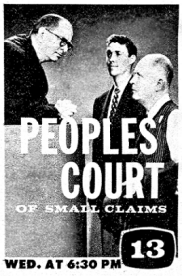
UCLA Law School Prof. Orrin B. Evans is seen in a "TV Guide" ad as the judge on the 1959 courtroom series, "Peoples' Court of Small Claims."
Thursday, May 22, 2003
Page 15
REMINISCING (Column)
Orrin B. Evans: Judge of a ‘People’s Court’ in 1959
By ROGER M. GRACE
“Restrained, thoughtful, judicial.”
That’s how Pasadena criminal defense lawyer David R. Evans describes his late father in portraying a judge on the original “People’s Court” — the full name of the series being the “People’s Court of Small Claims.” It was a nationally syndicated, half-hour program which aired locally on KCOP, Channel 13, starting on Feb. 11, 1959.
While that program, which lasted a single season, might not be well remembered, the man who played the judge is. Orrin B. Evans had become a USC law professor in 1947; in 1963, he was appointed dean, serving in that role for five years, years that were pivotal in the school’s development. He retired from the academic world in 1980, after having attained recognition as a leading educator and legal writer, and died five years later.
|
|
UCLA Law School Prof. Orrin B. Evans is seen in a "TV Guide" ad as the judge on the 1959 courtroom series, "Peoples' Court of Small Claims." |
On TV, Orrin B. Evans presided in a subdued manner over simulated small claims proceedings, three cases in each half-hour session. David Evans, a past president of the Criminal Courts Bar Assn. and the Beverly Hills Bar Assn., said his father possessed “a deep reverence for the bench,” his own father, Evan A. Evans, having served on the Seventh U.S. Circuit Court of Appeals (from 1916-48). Adverting to boisterous TV depictions of court proceedings currently on the air, David Evans said his father “would be appalled at this stuff.” Asked to compare his father’s show to “Judge Judy,” he responded, simply: “Different planets.”
The lawyer recounted that as a young teenager, he appeared on his father’s show as a plaintiff, suing over defects in an ant farm he had supposedly purchased. His sister and grandmother also portrayed litigants, in other episodes, he noted.
He said that as he recalls it, “they gave you a very light story line, and you improvised within that.”
There was similar barebones scripting on “Traffic Court,” which began on KABC June 7, 1957, and started the trend of mock courtroom shows. There were other similarities between the two programs.
Edgar Allan Jones Jr. in March, 1958 succeeded Evelle Younger as the judge on “Traffic Court,” which became an ABC network show from June to September of that year. Jones, too, was a law school professor — but across town, at UCLA.
Producers of the two shows accommodated their respective stars’ commitments to teaching duties by taping episodes on weekends (an accommodation also extended to Jones in connection with ABC’s “Day in Court” and “Accused” in which he portrayed the judge.)
“Traffic Court” and “People’s Court” were both based on actual cases. Both shows strove for accuracy, rather than dramatic effect.
And both commanded high ratings hereabouts. David Evans said that his father’s show was “quite successful in L.A.,” and noted that in San Diego, “People’s Court” regularly “beat out Wagon Train” on NBC.
The make-believe judges each had children who became California lawyers. Both of Orrin B. Evans’ sons are practicing members of the bar, and Jones, the father of 11, has three sons and a daughter who are lawyers.
Also, neither television judge was a member of the State Bar of California.
For Evans, not being a California lawyer meant that he met a job requirement. Son Evan G. Evans (named after his grandfather) explained that those planning the show were “looking for someone who was fairly articulate and gave a judicial appearance but was not a member of the California bar.” Back then, it was the prevalent view that for lawyers to appear on television court shows was a form of advertising — and thus an ethics violation (see “Perspectives,” May 16).
Evan Evans, a Corona sole practitioner, noted that his father had been admitted in two or three other states.
No videotapes of “Traffic Court” or Jones’ other shows are apparently extant (for reasons to be discussed next week). But there is in existence a videotape of Evans on “People’s Court” — though you won’t find it for rent at Blockbuster.
The series was taped in a small studio at KCOP (on La Brea Avenue), one of the first stations in the nation equipped with videotape apparatus. Orrin B. Evans’ daughter, Margaret Evans, worked for KCOP. The kind folk there wanted her to have copies of the three segments of the show with family members playing the roles of litigants. However, a copy of the tape would have been of no use to her; there were no home VCRs then. The former school teacher told me that the KCOP technicians transferred the segments to film, so she could show them on a home projector.
With home movies now a thing of the past, she recently had the film transferred to VHS cassettes. And so it is that the progeny of Orrin B. Evans can view segments of that long-ago show starring their dad.
Copyright 2003, Metropolitan News Company